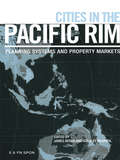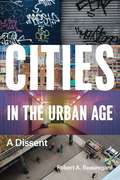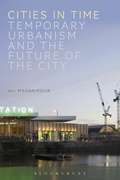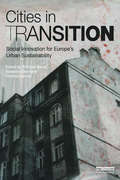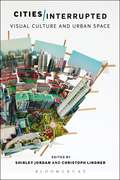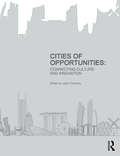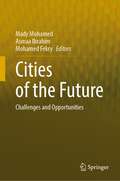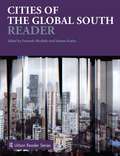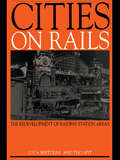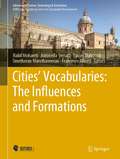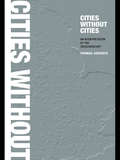- Table View
- List View
Cities in the Pacific Rim
by James Berry Stanley McGrealThe cities of the Pacific Rim are in one of the most dynamic spheres of the global economy. In the twenty first century the focus of global affairs is destined to shift from the West to the East. These cities offer a wide range of different responses to the demands that rapid growth puts on planning and infrastructure : from the laxity that has lead to the urban sprawl of Bangkok to the regulation that is characteristic of Singapore. This book considers the interactive relationships between the operation of the planning system and the role and performance of property development and real estate markets in 14 Pacific Rim cities drawn from both the Eastern and Western perspective. The dynamic underlying these relationships considers the interplay between administrative structures, legislative controls and policy issues examining the role of actors and agencies in the property development and investment process.
Cities in the Pacific Rim: Planning Systems And Property Markets
by James Berry Stanley McGrealThe cities of the Pacific Rim are in one of the most dynamic spheres of the global economy. In the twenty first century the focus of global affairs is destined to shift from the West to the East. These cities offer a wide range of different responses to the demands that rapid growth puts on planning and infrastructure : from the laxity that has lead to the urban sprawl of Bangkok to the regulation that is characteristic of Singapore. This book considers the interactive relationships between the operation of the planning system and the role and performance of property development and real estate markets in 14 Pacific Rim cities drawn from both the Eastern and Western perspective. The dynamic underlying these relationships considers the interplay between administrative structures, legislative controls and policy issues examining the role of actors and agencies in the property development and investment process.
Cities in the Urban Age: A Dissent
by Robert A. BeauregardWe live in a self-proclaimed Urban Age, where we celebrate the city as the source of economic prosperity, a nurturer of social and cultural diversity, and a place primed for democracy. We proclaim the city as the fertile ground from which progress will arise. Without cities, we tell ourselves, human civilization would falter and decay. In Cities in the Urban Age, Robert A. Beauregard argues that this line of thinking is not only hyperbolic—it is too celebratory by half. For Beauregard, the city is a cauldron for four haunting contradictions. First, cities are equally defined by both their wealth and their poverty. Second, cities are simultaneously environmentally destructive and yet promise sustainability. Third, cities encourage rule by political machines and oligarchies, even as they are essentially democratic and at least nominally open to all. And fourth, city life promotes tolerance among disparate groups, even as the friction among them often erupts into violence. Beauregard offers no simple solutions or proposed remedies for these contradictions; indeed, he doesn’t necessarily hold that they need to be resolved, since they are generative of city life. Without these four tensions, cities wouldn’t be cities. Rather, Beauregard argues that only by recognizing these ambiguities and contradictions can we even begin to understand our moral obligations, as well as the clearest paths toward equality, justice, and peace in urban settings.
Cities in the Urban Age: A Dissent
by Robert A. BeauregardWe live in a self-proclaimed Urban Age, where we celebrate the city as the source of economic prosperity, a nurturer of social and cultural diversity, and a place primed for democracy. We proclaim the city as the fertile ground from which progress will arise. Without cities, we tell ourselves, human civilization would falter and decay. In Cities in the Urban Age, Robert A. Beauregard argues that this line of thinking is not only hyperbolic—it is too celebratory by half. For Beauregard, the city is a cauldron for four haunting contradictions. First, cities are equally defined by both their wealth and their poverty. Second, cities are simultaneously environmentally destructive and yet promise sustainability. Third, cities encourage rule by political machines and oligarchies, even as they are essentially democratic and at least nominally open to all. And fourth, city life promotes tolerance among disparate groups, even as the friction among them often erupts into violence. Beauregard offers no simple solutions or proposed remedies for these contradictions; indeed, he doesn’t necessarily hold that they need to be resolved, since they are generative of city life. Without these four tensions, cities wouldn’t be cities. Rather, Beauregard argues that only by recognizing these ambiguities and contradictions can we even begin to understand our moral obligations, as well as the clearest paths toward equality, justice, and peace in urban settings.
Cities in the Urban Age: A Dissent
by Robert A. BeauregardWe live in a self-proclaimed Urban Age, where we celebrate the city as the source of economic prosperity, a nurturer of social and cultural diversity, and a place primed for democracy. We proclaim the city as the fertile ground from which progress will arise. Without cities, we tell ourselves, human civilization would falter and decay. In Cities in the Urban Age, Robert A. Beauregard argues that this line of thinking is not only hyperbolic—it is too celebratory by half. For Beauregard, the city is a cauldron for four haunting contradictions. First, cities are equally defined by both their wealth and their poverty. Second, cities are simultaneously environmentally destructive and yet promise sustainability. Third, cities encourage rule by political machines and oligarchies, even as they are essentially democratic and at least nominally open to all. And fourth, city life promotes tolerance among disparate groups, even as the friction among them often erupts into violence. Beauregard offers no simple solutions or proposed remedies for these contradictions; indeed, he doesn’t necessarily hold that they need to be resolved, since they are generative of city life. Without these four tensions, cities wouldn’t be cities. Rather, Beauregard argues that only by recognizing these ambiguities and contradictions can we even begin to understand our moral obligations, as well as the clearest paths toward equality, justice, and peace in urban settings.
Cities in the Urban Age: A Dissent
by Robert A. BeauregardWe live in a self-proclaimed Urban Age, where we celebrate the city as the source of economic prosperity, a nurturer of social and cultural diversity, and a place primed for democracy. We proclaim the city as the fertile ground from which progress will arise. Without cities, we tell ourselves, human civilization would falter and decay. In Cities in the Urban Age, Robert A. Beauregard argues that this line of thinking is not only hyperbolic—it is too celebratory by half. For Beauregard, the city is a cauldron for four haunting contradictions. First, cities are equally defined by both their wealth and their poverty. Second, cities are simultaneously environmentally destructive and yet promise sustainability. Third, cities encourage rule by political machines and oligarchies, even as they are essentially democratic and at least nominally open to all. And fourth, city life promotes tolerance among disparate groups, even as the friction among them often erupts into violence. Beauregard offers no simple solutions or proposed remedies for these contradictions; indeed, he doesn’t necessarily hold that they need to be resolved, since they are generative of city life. Without these four tensions, cities wouldn’t be cities. Rather, Beauregard argues that only by recognizing these ambiguities and contradictions can we even begin to understand our moral obligations, as well as the clearest paths toward equality, justice, and peace in urban settings.
Cities in the Urban Age: A Dissent
by Robert A. BeauregardWe live in a self-proclaimed Urban Age, where we celebrate the city as the source of economic prosperity, a nurturer of social and cultural diversity, and a place primed for democracy. We proclaim the city as the fertile ground from which progress will arise. Without cities, we tell ourselves, human civilization would falter and decay. In Cities in the Urban Age, Robert A. Beauregard argues that this line of thinking is not only hyperbolic—it is too celebratory by half. For Beauregard, the city is a cauldron for four haunting contradictions. First, cities are equally defined by both their wealth and their poverty. Second, cities are simultaneously environmentally destructive and yet promise sustainability. Third, cities encourage rule by political machines and oligarchies, even as they are essentially democratic and at least nominally open to all. And fourth, city life promotes tolerance among disparate groups, even as the friction among them often erupts into violence. Beauregard offers no simple solutions or proposed remedies for these contradictions; indeed, he doesn’t necessarily hold that they need to be resolved, since they are generative of city life. Without these four tensions, cities wouldn’t be cities. Rather, Beauregard argues that only by recognizing these ambiguities and contradictions can we even begin to understand our moral obligations, as well as the clearest paths toward equality, justice, and peace in urban settings.
Cities in the Urban Age: A Dissent
by Robert A. BeauregardWe live in a self-proclaimed Urban Age, where we celebrate the city as the source of economic prosperity, a nurturer of social and cultural diversity, and a place primed for democracy. We proclaim the city as the fertile ground from which progress will arise. Without cities, we tell ourselves, human civilization would falter and decay. In Cities in the Urban Age, Robert A. Beauregard argues that this line of thinking is not only hyperbolic—it is too celebratory by half. For Beauregard, the city is a cauldron for four haunting contradictions. First, cities are equally defined by both their wealth and their poverty. Second, cities are simultaneously environmentally destructive and yet promise sustainability. Third, cities encourage rule by political machines and oligarchies, even as they are essentially democratic and at least nominally open to all. And fourth, city life promotes tolerance among disparate groups, even as the friction among them often erupts into violence. Beauregard offers no simple solutions or proposed remedies for these contradictions; indeed, he doesn’t necessarily hold that they need to be resolved, since they are generative of city life. Without these four tensions, cities wouldn’t be cities. Rather, Beauregard argues that only by recognizing these ambiguities and contradictions can we even begin to understand our moral obligations, as well as the clearest paths toward equality, justice, and peace in urban settings.
Cities in Time: Temporary Urbanism and the Future of the City
by Ali MadanipourFrom street-markets and pop-up shops to art installations and Olympic parks, the temporary use of urban space is a growing international trend in architecture and urban design. Partly a response to economic and ecological crisis, it also claims to offer a critique of the status quo and an innovative way forward for the urban future. Cities in Time aims to explore and understand the phenomenon, offering a first critical and theoretical evaluation of temporary urbanism and its implications for the present and future of our cities.The book argues that temporary urbanism needs to be understood within the broader context of how different concepts of time are embedded in the city. In any urban place, multiple, discordant and diverse timeframes are at play – and the chapters here explore these different conceptions of temporality, their causes and their effects. Themes explored include how institutionalised time regulates everyday urban life, how technological and economic changes have accelerated the city's rhythms, our existential and personal senses of time, concepts of memory and identity, virtual spaces, ephemerality and permanence.
Cities in Time: Temporary Urbanism and the Future of the City
by Ali MadanipourFrom street-markets and pop-up shops to art installations and Olympic parks, the temporary use of urban space is a growing international trend in architecture and urban design. Partly a response to economic and ecological crisis, it also claims to offer a critique of the status quo and an innovative way forward for the urban future. Cities in Time aims to explore and understand the phenomenon, offering a first critical and theoretical evaluation of temporary urbanism and its implications for the present and future of our cities.The book argues that temporary urbanism needs to be understood within the broader context of how different concepts of time are embedded in the city. In any urban place, multiple, discordant and diverse timeframes are at play – and the chapters here explore these different conceptions of temporality, their causes and their effects. Themes explored include how institutionalised time regulates everyday urban life, how technological and economic changes have accelerated the city's rhythms, our existential and personal senses of time, concepts of memory and identity, virtual spaces, ephemerality and permanence.
Cities in Transition: Social Innovation for Europe’s Urban Sustainability
by Susanne Elsen Thomas Sauer Cristina GarzilloCities in Transition focuses on the sustainability transitions initiated in 40 European cities. The book presents the incredible wealth of insights gathered through hundreds of interviews and questionnaires. Four key domains—local energy systems, local green spaces, local water systems and local labour markets—have been the focus of the field research investigating local potentials for social innovation and new forms of civil society self-organisation. Examining the potential of new organizational frameworks like co-operatives, multi-stakeholder constructions, local-regional partnerships and networks for the success of such transitions, this book presents the key ingredients of a sustainable urban community as a viable concept to address current global financial, environmental and social challenges. Crucial reading for academics and practitioners of urban planning and sustainability in Europe, Cities in Transition is an innovative roadmap for sustainability in changing cities.
Cities in Transition: Social Innovation for Europe’s Urban Sustainability
by Susanne Elsen Thomas Sauer Cristina GarzilloCities in Transition focuses on the sustainability transitions initiated in 40 European cities. The book presents the incredible wealth of insights gathered through hundreds of interviews and questionnaires. Four key domains—local energy systems, local green spaces, local water systems and local labour markets—have been the focus of the field research investigating local potentials for social innovation and new forms of civil society self-organisation. Examining the potential of new organizational frameworks like co-operatives, multi-stakeholder constructions, local-regional partnerships and networks for the success of such transitions, this book presents the key ingredients of a sustainable urban community as a viable concept to address current global financial, environmental and social challenges. Crucial reading for academics and practitioners of urban planning and sustainability in Europe, Cities in Transition is an innovative roadmap for sustainability in changing cities.
Cities Interrupted: Visual Culture and Urban Space
by Shirley Jordan Christoph LindnerCities Interrupted explores the potential of visual culture – in the form of photography, film, performance, architecture, urban design, and mixed media – to strategically interrupt processes of globalization in contemporary urban spaces. Looking at cities such as Amsterdam, Beijing, Doha, London, New York, and Paris, the book brings together original essays to reveal how the concept of 'interruption' in global cities enables new understanding of the forms of space, experience, and community that are emerging in today's rapidly transforming urban environments.The idea of 'interruption' addressed in this book refers to deliberate interventions in the spaces and communities of contemporary cities – interventions that seek to disrupt or destabilize the experience of everyday urban life through creative practice. Interruption is used as an analytic and conceptual tool to challenge – and explore alternatives to – the narratives of speed, hyper-mobility, rapid growth, and incessant exchange and flow that have dominated critical thinking on global cities.Bringing art and creative practice into the centre of discussions about the future of cities, alongside discussions of development, design, justice, health, sustainability, technology, and citizenship, this book is essential reading for anyone working at the intersections of a range of urban, cultural and visual fields, including urban studies, urban design and architecture, visual studies, cultural studies, media studies, art history, and social and cultural geography.
Cities Interrupted: Visual Culture and Urban Space
by Shirley Jordan Christoph LindnerCities Interrupted explores the potential of visual culture – in the form of photography, film, performance, architecture, urban design, and mixed media – to strategically interrupt processes of globalization in contemporary urban spaces. Looking at cities such as Amsterdam, Beijing, Doha, London, New York, and Paris, the book brings together original essays to reveal how the concept of 'interruption' in global cities enables new understanding of the forms of space, experience, and community that are emerging in today's rapidly transforming urban environments.The idea of 'interruption' addressed in this book refers to deliberate interventions in the spaces and communities of contemporary cities – interventions that seek to disrupt or destabilize the experience of everyday urban life through creative practice. Interruption is used as an analytic and conceptual tool to challenge – and explore alternatives to – the narratives of speed, hyper-mobility, rapid growth, and incessant exchange and flow that have dominated critical thinking on global cities.Bringing art and creative practice into the centre of discussions about the future of cities, alongside discussions of development, design, justice, health, sustainability, technology, and citizenship, this book is essential reading for anyone working at the intersections of a range of urban, cultural and visual fields, including urban studies, urban design and architecture, visual studies, cultural studies, media studies, art history, and social and cultural geography.
Cities of Opportunities: Connecting Culture and Innovation
by Jason PomeroyCulture refers to not only the arts but also other manifestations of human intellectual achievement regarded collectively. It similarly refers to the customs, institutions, and achievements of a social group, a people, or a nation. Innovation refers to the action or process of change, alteration, or revolution; a new method of idea creation or product that may bring about change. It is easy to assume that innovation may be juxtaposed to the preservation of culture and time-tested rituals. Yet as human settlements grew; and as streets and squares evolved through the diverse exchanges of people trading, celebrating, rallying and socially interacting, it should come as little surprise that cities and its places would become, and continue to be, centres of culture and innovation that can be inextricably linked. Culture and Innovation in cities can potentially take on different complexions if viewed through the lens of academics and practitioners drawn from different geographies, disciplines, or fields of expertise when addressing particular urban challenges. It is through this complexity of views that this book seeks to provide a broad perspective on culture and innovation in the context of global cities today; and a rich cornucopia of insights from thought leaders within their respective fields to shape the cities of tomorrow.
Cities of Opportunities: Connecting Culture and Innovation
by Jason PomeroyCulture refers to not only the arts but also other manifestations of human intellectual achievement regarded collectively. It similarly refers to the customs, institutions, and achievements of a social group, a people, or a nation. Innovation refers to the action or process of change, alteration, or revolution; a new method of idea creation or product that may bring about change. It is easy to assume that innovation may be juxtaposed to the preservation of culture and time-tested rituals. Yet as human settlements grew; and as streets and squares evolved through the diverse exchanges of people trading, celebrating, rallying and socially interacting, it should come as little surprise that cities and its places would become, and continue to be, centres of culture and innovation that can be inextricably linked. Culture and Innovation in cities can potentially take on different complexions if viewed through the lens of academics and practitioners drawn from different geographies, disciplines, or fields of expertise when addressing particular urban challenges. It is through this complexity of views that this book seeks to provide a broad perspective on culture and innovation in the context of global cities today; and a rich cornucopia of insights from thought leaders within their respective fields to shape the cities of tomorrow.
Cities of the Future: Challenges and Opportunities
by Mady Mohamed Asmaa Ibrahim Mohamed FekryThis book seeks to address the key challenges and opportunities of "future cities" embracing novel approaches and grounded technologies in pursuing a vision for smart, inclusive cities. The objective of this book is to discuss multiple areas at the local, national, and international levels and how these challenges can hinder the development objectives planned to be achieved by the cities of the future. The chapters featured in this collection were presented at the 6th Memaryat International Conference (MIC 2022), held at the Effat University, Jeddah. MIC’s objective is to build bridges between science, technology, and innovation, seen as the key levers of attaining the SDGs.This book provides the most innovative ideas presented at the conference to address the key manifestation of “future cities" to embrace novel approaches and grounded technologies in the pursue of a vision for smart inclusive cities. It thus represents a platform for diverse contributions from academics and practitioners to present their different perspectives addressed theoretically as well as in practice concerning the challenges and opportunities of future cities. This includes contributions from decision-makers, architects, urban planners, urban designers, entrepreneurs, and educators to stimulate discussion covering the latest on the challenges and opportunities for better future cities in the different domains of architecture, building science and technology, environmental design, mobility & infrastructure, urban design & landscape, housing & real estate developments, urban planning, governance, socio-cultural & economic development, community engagement, tourism and heritage revitalization.
Cities of the Global South Reader (Routledge Urban Reader Series)
by Faranak Miraftab Neema KudvaThe Cities of the Global South Reader adopts a fresh and critical approach to the fi eld of urbanization in the developing world. The Reader incorporates both early and emerging debates about the diverse trajectories of urbanization processes in the context of the restructured global alignments in the last three decades. Emphasizing the historical legacies of colonialism, the Reader recognizes the entanglement of conditions and concepts often understood in binary relations: first/third worlds, wealth/poverty, development/underdevelopment, and inclusion/exclusion. By asking: “whose city? whose development?” the Reader rigorously highlights the fractures along lines of class, race, gender, and other socially and spatially constructed hierarchies in global South cities. The Reader’s thematic structure, where editorial introductions accompany selected texts, examines the issues and concerns that urban dwellers, planners, and policy makers face in the contemporary world. These include the urban economy, housing, basic services, infrastructure, the role of non-state civil society-based actors, planned interventions and contestations, the role of diaspora capital, the looming problem of adapting to climate change, and the increasing spectre of violence in a post 9/11 transnational world. The Cities of the Global South Reader pulls together a diverse set of readings from scholars across the world, some of which have been written specially for the volume, to provide an essential resource for a broad interdisciplinary readership at undergraduate and postgraduate levels in urban geography, urban sociology, and urban planning as well as disciplines related to international and development studies. Editorial commentaries that introduce the central issues for each theme summarize the state of the field and outline an associated bibliography. They will be of particular value for lecturers, students, and researchers, making the Cities of the Global South Reader a key text for those interested in understanding contemporary urbanization processes.
Cities of the Global South Reader (Routledge Urban Reader Series)
by Faranak Miraftab Neema KudvaThe Cities of the Global South Reader adopts a fresh and critical approach to the fi eld of urbanization in the developing world. The Reader incorporates both early and emerging debates about the diverse trajectories of urbanization processes in the context of the restructured global alignments in the last three decades. Emphasizing the historical legacies of colonialism, the Reader recognizes the entanglement of conditions and concepts often understood in binary relations: first/third worlds, wealth/poverty, development/underdevelopment, and inclusion/exclusion. By asking: “whose city? whose development?” the Reader rigorously highlights the fractures along lines of class, race, gender, and other socially and spatially constructed hierarchies in global South cities. The Reader’s thematic structure, where editorial introductions accompany selected texts, examines the issues and concerns that urban dwellers, planners, and policy makers face in the contemporary world. These include the urban economy, housing, basic services, infrastructure, the role of non-state civil society-based actors, planned interventions and contestations, the role of diaspora capital, the looming problem of adapting to climate change, and the increasing spectre of violence in a post 9/11 transnational world. The Cities of the Global South Reader pulls together a diverse set of readings from scholars across the world, some of which have been written specially for the volume, to provide an essential resource for a broad interdisciplinary readership at undergraduate and postgraduate levels in urban geography, urban sociology, and urban planning as well as disciplines related to international and development studies. Editorial commentaries that introduce the central issues for each theme summarize the state of the field and outline an associated bibliography. They will be of particular value for lecturers, students, and researchers, making the Cities of the Global South Reader a key text for those interested in understanding contemporary urbanization processes.
Cities of Words: Pedagogical Letters on a Register of the Moral Life
by Stanley CavellThis book--which presents a course of lectures Cavell presented several times toward the end of his teaching career at Harvard--links masterpieces of moral philosophy and classic Hollywood comedies to fashion a new way of looking at our lives and learning to live with ourselves.
Cities on Rails: The Redevelopment of Railway Stations and their Surroundings
by Luca Bertolini Tejo SpitThe development of railway stations and their surroundings is an emerging feature in current urban projects. Based on a series of the most inspiring contemporary European examples of station redevelopment, this book will help planners and urban designers understand the specific and complex nature of station locations. Based on their extensive research, the authors, pioneers of studies in the field in the last few years, harness and expand the body of knowledge and present guiding principles and conditions for successful implementation of such planning projects.
Cities on Rails: The Redevelopment of Railway Stations and their Surroundings
by Luca Bertolini Tejo SpitThe development of railway stations and their surroundings is an emerging feature in current urban projects. Based on a series of the most inspiring contemporary European examples of station redevelopment, this book will help planners and urban designers understand the specific and complex nature of station locations. Based on their extensive research, the authors, pioneers of studies in the field in the last few years, harness and expand the body of knowledge and present guiding principles and conditions for successful implementation of such planning projects.
Cities’ Vocabularies: The Influences and Formations (Advances in Science, Technology & Innovation)
by Nabil Mohareb Antonella Versaci Yasser Mahgoub Sreetheran Maruthaveeran Francesco AlbertiThis book discusses several topics regarding different vocabularies, such as sacred architecture, heritage buildings, open spaces, landmarks, and street escapes, all of which have a direct influence on the city form. The city form is also affected by the indirect impact of the citizens themselves, for example their culture, which in turn depends on the arts, as can be seen and embodied in morals, paintings, media, digital art, and sculpture. The book also examines the fundamental elements that are responsible for the identity of the city. Presenting case studies that demonstrate the how implementing the concept of the responsibility of architecture and arts affects the development of our cities, the book offers a new approach that is based on the available features of a city and explores how planners and decision-makers can use these features to address the myriad problems that our cities are facing.
Cities Without Cities: An Interpretation of the Zwischenstadt
by Thomas SievertsThis book investigates the characteristics of today's built environment: no longer simply a city but increasingly large conurbations made up of a number of development clusters, linked by transport routes. The diffusion of the once compact city into a city web, the 'meta city' is mirrored by changes in society from communities with strong social cohesion and interest in their towns and cities to individuals pursing their own goals, with global social links and little interest in their city.
Cities Without Cities: An Interpretation of the Zwischenstadt
by Thomas SievertsThis book investigates the characteristics of today's built environment: no longer simply a city but increasingly large conurbations made up of a number of development clusters, linked by transport routes. The diffusion of the once compact city into a city web, the 'meta city' is mirrored by changes in society from communities with strong social cohesion and interest in their towns and cities to individuals pursing their own goals, with global social links and little interest in their city.
